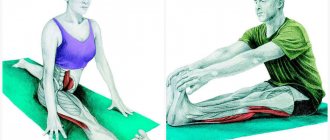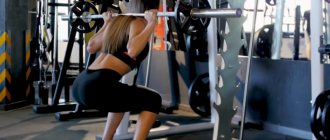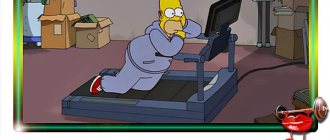Types of muscle pain
Experts identify several types of pain that occurs after sports training. These include:
- Moderate post-workout pain. It appears due to excessive physical activity. A person feels mild soreness, muscle fatigue, a feeling of fullness and swelling of the muscles. The soreness becomes worse when the tissue contracts or stretches completely. The pain continues for several days, but is not dangerous.
- Delayed muscle pain. It does not appear immediately, but after 2-3 days after training. It appears clearly. The cause of pain is considered to be changes in load, long-term lack of physical activity. The symptom is also not dangerous and goes away on its own as the muscles get used to the load.
- Pain from injuries. It is acute and hinders movement. Muscles are usually damaged due to insufficient warm-up before the main set of exercises.
Also, many athletes experience burning pain that occurs when repeating the same action multiple times.
What types of activities can cause muscle pain after exercise?
Any movement that you are not used to can cause muscle pain after exercise. Taking on a new exercise that is more challenging than your usual workout, or working your muscles in a different way can cause muscle soreness after workouts.
Causes of muscle pain
Pain in the legs after sports activities is a common phenomenon. There are several “provocateurs” of an unpleasant symptom.
Natural
The main reason why legs hurt after sports training is muscle contraction for a long time. In this case, a pain similar to a burning sensation occurs. It goes away quickly after completing the exercises. Such pain is not dangerous.
Pain often appears the day after training. It is also natural in nature and is associated with microtraumas of muscle tissue. The muscles need to get used to the load so that unpleasant symptoms no longer occur.
Pathological
Pain in the muscle tissues of the legs during training is not always due to overexertion. Painful sensations occur due to the following reasons:
- Injuries to the muscles of the knee and other parts of the extremities.
- Disturbance of metabolic processes in tissues.
- Joint diseases.
- Inflammatory process in muscles.
- Neuralgia.
- Cramps.
For the listed pathological causes, additional symptoms characteristic of a specific disease are observed.
Why do muscles hurt after training?
Soreness (or delayed onset muscle soreness syndrome) is muscle soreness that begins 6-8 hours after exercise and peaks around 24-48 hours. Symptoms decrease in intensity after 72 hours, but the timing and symptoms may vary among individuals.
The main cause of muscle soreness is eccentric muscle contractions because they place significant stress on the muscles.
Soreness is most pronounced when you change something in your training program (adding a new type of exercise, increasing the intensity or volume of approaches) or if you are new to sports in general. Your body begins to adapt to prepare your muscles to handle the same load in the future. That's why, when you first find yourself in the gym and perform squats or lunges with a weight of 5-7 kg, you need to be prepared for the fact that your muscles may be very sore the next day. If you continue to exercise despite the pain, your muscles will rebuild and the discomfort will go away.
All types of muscle contractions can cause pain, but eccentric contractions, in which the muscle lengthens, lead to soreness most often. This type of contraction occurs when running downhill, when lowering a weight, or at the bottom of a squat. There is evidence that some exercises cause more muscle soreness in the upper body than in the lower body.
Muscle discomfort is the most common characteristic of delayed onset muscle pain syndrome, but other symptoms exist. According to the American College of Sports Medicine (ACSM), decreased range of motion, swelling, local tenderness, and decreased muscle strength are also observed. Symptoms appear gradually after exercise (not to be confused with the acute pain that can occur during exercise!).
How to relieve pain?
If the leg muscles are very sore after training due to severe overexertion or stagnation of lactic acid, then no therapeutic measures are required. This pain will go away on its own. If the cause of the pain is pathology, then you should consult a doctor and undergo an examination.
Ointments
Post-workout pain can be relieved with topical remedies. Pharmacies sell a large number of creams that relax, warm up muscles, relieve spasms, restore normal lymph flow, and normalize blood circulation in the legs.
There are also ointments that promote the rapid removal of uric acid from muscles, enriching tissues with useful substances that are necessary for the creation of new muscle fibers.
The following local remedies are effective:
- "Gevkamen", which has an analgesic and warming effect.
- "Nikoflex", capable of relieving excessive tension, preventing spasms and cramps.
- "Menovazin", which helps eliminate pain through a cold effect.
- “Richtofit”, which relieves muscle soreness.
Creams are applied to the affected area, covering the healthy area around it.
Therapeutic baths
What to do if the muscles in your legs hurt after training? Take a bath. Doctors recommend using moderately hot water and adding salt to it. With the help of this substance, blood circulation is normalized, a lymphatic drainage effect is produced, muscles relax, and pain recedes. To achieve a positive result, you need to dissolve a glass of salt in a full bath. It is allowed to use both regular food and seafood products.
If you've worked hard in the gym, you'll probably have sore muscles the next day. Of course, this does not mean that pain should be present after every session, but still, soreness signals progress. But the pain can be different - weak or strong. Should you skip the class and wait for it to pass, or should you still go to the training?
If your muscles hurt after training: can you exercise or not?
You thought that the pain would go away in one no, but no - it did not disappear even after 1-2 days. But your training is going according to plan, how will you do it? Some people advise you to exercise through force, and others advise you to abstain. But what do the doctors say?
What causes sore throat? During training, lactic acid begins to accumulate in large quantities in your muscles, this is caused by a decrease in oxygen levels in the body. Most often, acid accumulates in beginners, as well as in those who have tried a new training program.
Don't confuse muscle pain after exercise with pain due to a sprain. The soreness appears only the next day after the lesson and can last 2-5 days, depending on the characteristics of your body. If it does not disappear, be sure to consult a doctor - you may have injured your ligaments.
If your muscles hurt after training, should you exercise or not? We'll make you happy - you won't have to miss your workout! In fact, sore throat is not a hindrance, and you can get ready to go to the gym. This is not an injury or sprain, so there are no contraindications.
But there is one “but” - the loads should be minimal. Try to push yourself less, reduce the intensity and weight, try not to overload yourself. On the contrary, if you don't exercise, your muscles will hurt even longer. Exercise will improve blood circulation and help reduce the amount of lactic acid, so after exercise you will feel less pain.
There is no need to concentrate on a specific muscle group; we recommend doing a workout that includes exercises for all groups. Even if your biceps or buttocks hurt, you don't need to concentrate on them specifically.
Don't be afraid of pain - this is progress. If you notice that your muscles haven't been sore lately, it's time to change your training program or increase the weight. They need loads and progress - so don’t be lazy and work hard!
Stretching
To reduce pain and prepare your body for training, do a 10-minute warm-up before your main activity. Well, after class, don’t forget to do a few stretching exercises - they will help warm up your muscles as much as possible.
How to reduce soreness
There is no one-size-fits-all solution to muscle pain, but you can try to reduce it. Take a hot bath with sea salt, go to the bathhouse or sauna with friends. There are also warming ointments on sale that will speed up blood circulation and reduce soreness. A massage won’t hurt either; you can do it yourself or contact a specialist.
Muscle pain is a sign of your progress in sports and don’t let it stop you. And despite the fact that many do not recommend attending classes if you have a sore throat, this is the wrong approach. Doctors strongly recommend not skipping workouts. Good luck!
Men's online magazine Mensweekly.ru
What should you not do if you have muscle pain?
If the pain in the leg muscles after sports activities is severe, then it is not recommended to continue training. It is worth giving the body more rest for full recovery. It is advisable to consult with a trainer: he can change the set of exercises, duration and intensity of their implementation.
If pain bothers you due to injury, then you can no longer train and you should visit a doctor. Further exercises after damage to muscle fibers are allowed to begin after complete recovery of the lower limb.
Is it possible to exercise if the pain has not gone away?
Everything is subjective and depends on your personal feelings. If necessary, you can make subsequent training easier, but if myalgia during strength training is tolerable, but you do not experience any particular discomfort, you can allow yourself to train at full strength.
With a competent approach and subsequent exercises, the pain will subside. But in case of severe manifestations, you should definitely refrain from intense physical activity and allow the body to recover.
When does muscle pain require medical attention?
If pain persists for 3 days after training, the cause may be an injury. There are different types of injuries to the lower extremities: bruise, sprain, rupture. Typically, trauma is accompanied by the following symptoms:
- swelling;
- hematoma;
- limited movement;
- redness of the skin in the affected area.
Pain in injuries is severe and intensifies with exercise. You should consult a doctor if the unpleasant sensation persists for more than 3 days, or if additional symptoms are present.
Thus, pain in the legs after training worries novice athletes. But it is not always associated with ordinary overvoltage. The causes of pain can be pathological, so you should carefully monitor your condition during training.
How to reduce or prevent pain?
In order to remove lactic acid from muscle fibers as quickly as possible, you should continue exercising in a moderate mode, keeping them in good shape with less physical activity. I would also like to note additional methods and means that will help reduce discomfort and speed up recovery.
Drugs
If we are talking about long-term work in the gym and regular sore throat, then first of all it is important to monitor your diet and add the necessary vitamins, microelements and nutrients to your diet. Creatine and amino acids, which are sold as supplements in sports nutrition stores, are very useful.
If we are talking about specific medications, then they are selected by the doctor depending on the cause of the pain syndrome or the stage of the inflammatory processes. In this context, I can distinguish three categories of drugs:
- Tablets in the form of non-narcotic analgesics - have minimal harm to other organs and systems (but only with short-term use). The most common options are Sulpirin and Analgin. In more serious cases, drugs based on ketorolac (Ketoprofen, Ketalgin, etc.) are prescribed.
- Nonsteroidal tablet drugs that relieve inflammation (Ibuprofen, Paracetamol, Nimesulide, Diclofenac).
- Narcotic tablets are dispensed only as prescribed by a doctor. They have a strong and long-lasting effect (Tramadol, Promedol).
Finally, first aid in this matter can be provided by pain-relieving ointments such as Voltaren, Diclofenac and Fastum-gel, or patches (Nanoplast, Voltaren).
Massages
Massage can be considered an excellent remedy. More experienced athletes can perform self-massage, but the best option is a professional sports massage performed by an experienced specialist.
Cold and hot shower
The best way to relieve tension and pain is external temperature exposure. A good warm-up in contrast with an invigorating cold stream is the best option to relax, restore, and then bring the muscle fibers into proper tone.
How to prevent discomfort?
One of the best ways to prevent post-workout muscle soreness is to begin any new activity program gently and gradually. To give your muscles time to adapt to new movements, you need to minimize soreness. There is not much evidence that warming up will be effective in preventing muscle soreness after exercise. But exercising with warm muscles will reduce your chances of injury and improve your performance. Although stretching has many benefits, there is currently no evidence that stretching before or after exercise helps reduce or prevent muscle soreness after exercise.
Pain after first workouts
Why do muscles hurt especially badly after the first workouts? First of all, this is due to the fact that your body is not adapted to the current loads, and cannot properly configure all body systems to combat this pain. The muscle pain itself after training is a type of adaptation mechanism, which means that your muscles adapt to the new activity. The next time you perform the same activity or exercise at the same intensity, there will be less muscle tissue damage, less pain, and you will recover faster.











